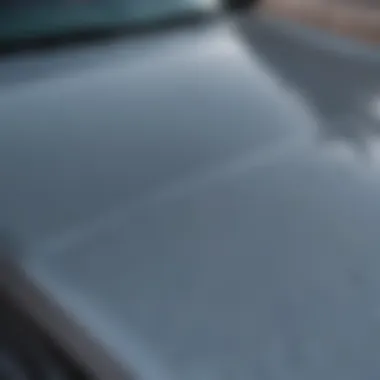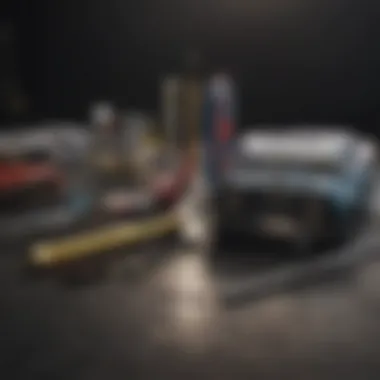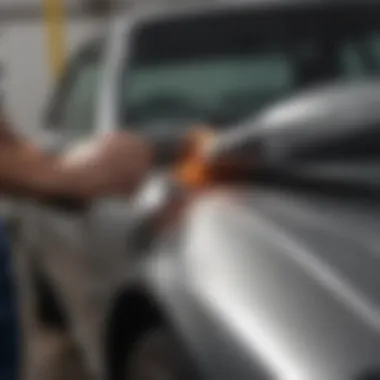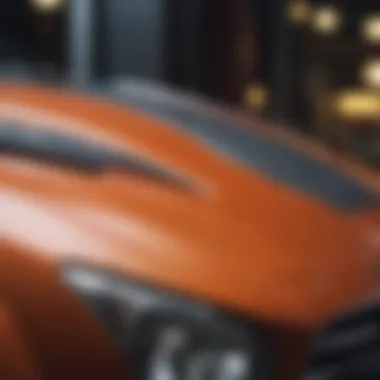A Practical Guide to Removing Small Dents from Cars


Intro
Small dents in cars can be a major annoyance for any vehicle owner. They not only affect the appearance but also can hinder resale value. Understanding the techniques for popping out these dents is becoming increasingly important. The good news is that many of these techniques can be performed without professional help.
In this article, readers will discover the various methods, tools, and tips to effectively address small dents. This knowledge empowers car owners to maintain the integrity of their vehicles’ appearances independently, also promoting a better understanding of vehicle upkeep.
Leveraging the right methods can make a significant difference without needing specialist intervention. This guide highlights some practical and effective solutions you can confidently use at home.
In-Depth Car Reviews
While this section typically goes into detail about vehicle specifications and features, our focus shifts to surface-level maintenance, highlighting practical solutions for everyday issues like dents. However, understanding how a vehicle is structured can aid in how dents can be accessed and repaired.
Overview of the Vehicle
For effective dent removal, delve into the material composition of the vehicle's body. Common materials include steel and aluminum, impacting dent repair methods.
Key Specifications
Knowing the specifications for specific models or brands may assist in choosing appropriate repair methods.
Performance Analysis
Small imperfections such as dents often hide deeper issues. Ensure repairs do not interfere with how the car is fundamentally designed or functions.
Interior and Exterior Design
Familiarity with the layout can guide in targeting each dent according to accessibility and challenges posed by the design.
Safety Ratings and Features
When performing any maintenance, safety should not be overlooked. Be aware of your environment and maintain safety protocols while handling tools.
Buying Advice
When deciding whether to repair a dent yourself or through professionals, factors affecting cost and time need consideration. Here are a few key points for decision-making:
- Budget Recommendations: Determine if your finances can support DIY supplies or professional service because initial costs vary.
- Financing Options: Some car maintenance services may offer financing plans for extensive repairs. Check these beforehand.
- Best Time to Buy: Repairing before major sales or trade-ins can enhance your vehicle’s appearance—it may also elevate interest.
- Resale Value Considerations: Remove visible dents preferably before resale; they can significantly affect market value.
- Comparing Similar Models: When looking for new vehicles, consider options with enhanced dent-resistant materials.
Technological Trends
Integrating case studies and insights on current trends could provide car owners with vital background when dealing with dent repairs. Keeping up with automotive technology ensures not only surface upkeep but also safety and performance enhancements.
Latest Innovation Highlights
Research recent developments in dent repairing tools, for instance, heated pullers can be useful in specific applications.
Impact of Technology on Driving and Safety
Dents cause issues not only of appearance but also fuel efficiency depending on their size and location on the car.
Future Trends and Predictions
Take note of forecasting w.r.t future materials in vehicles. Enhanced alloys will affect dent resistance and repair approaches in years to come.


How to Choose Technological Features
When choosing tools for dent repair, examine the innovations available in the DIY repair marketplace. Price and function should guide your selection.
Case Studies of Cutting-Edge Technology in Current Models
Some new models incorporate features that structurally distribute physical impacts better, potentially lessening dent occurrences.
Car Maintenance Tips
Managing your vehicle’s aesthetics not merely boils down to fixing surfaces but also involves an ongoing maintenance routine for preservation and avoidance of new dents.
Regular Maintenance Schedule
Create a detailed maintenance schedule that includes periodic inspections encouraging early dent detection.
DIY Tips and Tricks
Learn basic techniques, such as applying heat gently on the dent and following up with cool air, which may cause metal to revert back into place.
Common Problems and Solutions
For example, parking near areas heavy on foot traffic is practical; opting out minimizes surrounding risk concerns.
Importance of Professional Maintenance
While DIY methods can restore appearances, professional approaches may assure foundational restoration, especially for severe damages.
Seasonal Maintenance Practices
Seasonally vary your maintenance focus. Preparation for conditions that promote dents—like hail in the spring months—will counter dent formation proactively.
This guide encapsulates various methods. Achieve knowledge mastery through divides agreement in structural maintenance particularly concerning aesthetics and performance.
Understanding Car Dents
Understanding car dents is crucial for any vehicle owner. Dents may seem like minor inconveniences, but they can impact your vehicle’s appearance and resale value. Initiative in addressing small dents not only helps maintain the visual integrity of your car but also gives you a sense of ownership and responsibility over your vehicle.
What Causes Small Dents?
Small dents can originate from various everyday situations. Common causes include hail storms, parking lot mishaps, and even children playing nearby. Each occurrence leads to the same outcome – an unsightly dent on your vehicle’s surface. Understanding these causes enables car owners to take insight preventative measures in the future.
- Hail: Falling hail can create significant damage, particularly if the pellets are large. The impact it generates can forcefully push in the metal surface of the car.
- Improper Parking: Accidental contact with other vehicles or objects during parking often results in small dents. Lack of awareness in cramped spaces increases risk.
- Shopping Carts: An abandoned shopping cart rolling alongside can impact parked cars and leave marks or dents.
- Natural Incidents: Falling branches or objects can also lead to small imperfections on your vehicle.
Types of Dents
There are several types of dents, and understanding the differences can help predict the best method for repair.
- Shallow Dents: These are often the easiest to fix and require minimal tools or skills. Damage is superficial, and paint usually remains intact.
- Deep Dents: These dents extend deeper into the metal and may cause issues with paint. Repair typically involves more advanced techniques.
- Creased Dents: These announce themselves with a clear fold in the metal. Repairing creased dents usually necessitates a professional touch, as there is a risk of more damaging additional care.
- Combination Dents: These contain various features of the above types. Understanding the composition may dictate which approach is advisable.
It's important to identify the dent's attributes, including size, location, and type.
By grasping the fundamental principles surrounding car dents, vehicle owners can empower themselves. They can begin to address these much-dreaded blemishes with confidence and improved knowledge. Armored with this understanding, intervening in the dent’s life cycle becomes an achievable goal.
Assessing the Damage


Assessing the damage is crucial when it comes to addressing small dents in your vehicle. Understanding the extent of the dent will determine the necessary steps for effective removal. Failing to accurately gauge the damage can lead to unnecessary complications or ineffective repairs.
Some factors to consider include the depth of the dent, its location, and the size compared to the overall panel. Each of these aspects plays a significant role. Accurate assessment secures not only successful dent removal but also preservation of the car's surface integrity.
Identifying Depth and Location
To accurately identify the depth and location of the dent, a detailed inspection is paramount. Begin by examining the area closely. Minor dents may only slightly disrupt the paint layer, while deeper ones can warp the metal underneath.
- Lighting conditions: Utilize natural light or a directed LED flashlight to spot irregularities in the surface of the vehicle. This makes the dent more apparent.
- Touch testing: Gently run your hand over the area to feel the damage. If it feels smooth, the dent is likely shallow.
- Measuring tools: If available, employ a caliper or similar tool to measure the depth. Even a basic ruler can provide insights.
Understanding the location of the dent is equally important. Dents situated near seams or edges may require unique approaches to remove them without further damage.
Determining Repair Viability
Not all dents are suitable for DIY repair. Repair viability hinges on both the type and extent of damage. Evaluate whether the dent meets the criteria for self-maintenance.
Factors determining repair viability include:
- Material type: Different vehicles use various metals and plastics. Some materials respond well to hot methods, while others do not.
- Avoiding damage escalation: Severe dents, particularly those affecting the paint's integrity, risk causing more harm if improperly handled.
If the damage surpasses minor dents—perhaps extending to fractures or significant trapping of metal—consulting with a professional is advisable. Always weigh the potential benefits against risks, ensuring informed decision-making for every unique situation.
"Correctly assessing the damage often dictates the success of removal techniques. Proper evaluation is not to be rushed."
Common Tools for Dent Removal
When it comes to popping out small dents in your car, having the right tools is crucial. Each type of tool addresses specific challenges associated with dent removal. The proper tools can not only enhance efficiency but also help avoid causing further damage to the vehicle's surface. Investing time to choose suitable instruments ensures a more successful outcome in improving your vehicle's appearance.
Heat Sources
Heat is fundamental in many eventualities of dent removal. Applying heat makes the material of the car easier to manipulate. Typical heat sources include heat guns and hot water. A heat gun can moderate temperatures exactly, allowing localized repairs without affecting surrounding painted areas. Conversely, hot water is simple and quick—it can be poured directly onto the dent area without fuss.
Using an appropriate heat source significantly increases the chances of a successful dent removal.
Regular hair dryers can also serve a dual purpose by providing heat while also being domestic. Their downside lies in insufficient power for tougher dents. It is worth noting that too much heat can risk paint damage, making cautious application essential. In summation, effective understanding and cautious handling of heat sources plays a pivotal role in the dent removal process.
Prying Tools and Kits
Prying tools represent another necessity for those tackling dents alone. Tools like soft plastic pry bars can help in pushing out dents from behind without risking scratches or damage to paint surfaces. Dedicated dent repair kits often provide these tools along with guides that aid in the dent removal process.
When selecting a kit, ensure it includes a variety of prying tools specific for contours and tight spaces around the dent. Kits often consist of a blend of several types of tools, enabling users to have diverse options based on the dent's size and location. Always follow the manufacturer guidelines to maximize the effectiveness of each tool.
Suction Devices
Suction devices introduce a valuable technique to dent repair. They leverage pressure to pull out small dents in a straightforward manner. By creating a vacuum seal, a high-quality suction cup can pull the dent outward as you steady the surrounding area. This method is less invasive compared to others and requires minimal preparation.
Although easy to use, suction devices work best on minor, shallow dents. Using these correctly might require a few attempts to achieve the desired result. When finished, ensure to clean any residue left to maintain the vehicle’s integrity. Overall, these tools are a practical part of any dent repair toolkit to explore for small dents in your vehicle.
Best Practices for Successful Removal
When it comes to removing small dents from your car, following best practices is crucial. These methods can ensure better results while minimizing damage risk to your vehicle. Taking the time to understand effective removal strategies preserves not just the car's beauty but its value as well. Small dents, if handled improperly, can result in more significant issues, increasing the cost and complexity of repairs.
Safety Considerations


Working on your vehicle comes with safety risks. Before embarking on any dent removal process, keep these safety tips in mind:
- Personal Protective Gear: Always wear gloves to protect your hands from heat and sharp edges. Safety goggles are wise too, in case of loose debris.
- Workspace Preparation: Ensure your working area is clean and organized. This reduces the chance of accidents. Have all tools within reach before you begin.
- Proper Ventilation: Some methods can involve chemicals or emit fumes. Make sure you work in a well-ventilated space to avoid inhaling harmful substances.
- Vehicle Stability: Ensure your vehicle is parked on a flat surface. This helps avoid any unintentional movement while you work on it.
By adhering to these safety protocols, you create a secure environment conducive to effective repair work.
Testing on Non-visible Areas
Before applying a cherished technique to the visible areas of your vehicle, consider testing methods on non-visible parts. This is particularly important because:
- Damage Assessment: Often, certain materials may react adversely to various heating and cooling methods. Testing ensures you do not damage the finish accidentally.
- Understanding Results: What works on one area may not produce the same result on another section. Testing allows you to gauge effectiveness first before a full application.
- Gaining Confidence: By practicing on hidden spots, you build familiarity with the tools and method. This experiences enhance your effectiveness as you move to more visible areas.
Here are some tips when using non-visible areas for testing:
- Identify parts like the underside of bumpers or behind side mirrors. These are often out of sight, both for you and for onlookers.
- If results are not satisfactory, it saves you from any visible aesthetic disappointment on your car. If you face problems during testing, consult additional resources for alternative methods or approaches.
When to Seek Professional Help
When dealing with small dents in your vehicle, it is essential to recognize the right times to switch from a DIY approach to seeking professional assistance. Choosing to address minor issues through self-service can be empowering and rewarding, but some situations necessitate the expertise of trained technicians. This segment discusses key elements that can inform this decision, offering insights tailored for automotive enthusiasts and new car buyers.
Identifying Severe Damage
Not every dent is created equal. Some might appear harmless but, upon closer examination, may indicate underlying issues that require expert intervention. Severe damage could include:
- Creased Metal: Dents that cause a crease may impair the aesthetic integrity of your vehicle, often leaving a lasting visual defect that might not be fixable through standard DIY methods.
- Paint Damage: If the paint surrounding the dent is cracked or chipped, further attempts to remove the dent could lead to more extensive damage. Paint might need retouching, which is best handled by a professional.
- Structural Involvement: Any dents affecting the vehicle’s frame or structural components should never be underestimated. These issues require access to specialized equipment and expertise beyond typical home methods.
In cases of severe damage, it is better to consult with a professional to ensure comprehensive repair and preservation of the integrity of the vehicle.
Understanding Repair Costs
Understanding the costs associated with professional repair helps in making informed decisions. While addressing small dents may often seem straightforward, several elements can affect overall expenses. Here are key points to consider regarding repair costs:
- Type of Damage: As discussed before, the severity of the dent and associated damage plays a primary role.
- Location of the Damage: Dents in hard-to-reach areas often necessitate more labor and advanced tools.
- Repair Method: Many professionals employ different methods (such as Paintless Dent Repair vs. traditional bodywork), each with its pricing structure. It is advisable to ask for estimates based on repair methods.
- Resale Considerations: Investing in quality repairs can enhance a vehicle’s resale value, protecting against any undetected damages that may arise later.
It’s wise to gather multiple quotes before settling with a repair shop. This ensures not just cost-effectiveness but also a better understanding of what to expect.
When making crucial decisions about repairs, consider both short-term solutions and long-term impacts.
By understanding these considerations, car owners can navigate the confusing landscape of auto repairs, allowing them to either proceed with confidence toward a DIY solution or seek help when more complex issues arise.
Maintaining Your Vehicle's Aesthetic
Maintaining your vehicle’s aesthetic goes beyond just keeping it shiny. A well-maintained vehicle reflects the owner’s pride and care for their investment. Minor dings and dents can accumulate over time, leading to a general neglect of the car's overall appearance. Focusing on the aesthetic can not only beautify your car but also enhance its resale value. A car freely displaying dents might deter potential buyers even if mechanical features are top-notch. More importantly, an inviting appearance encourages routine checks and upkeep, preventing bigger issues down the line.
Regular Inspections
Conducting regular inspections is essential for maintaining your vehicle’s aesthetic. Keeping an eye on the exterior bodies will help spot any new dents or imperfections promptly. Schedule these inspections about once a month, or whenever you wash your car, to evaluate not only the appearance but the condition of the paint. Check surfaces in different lighting to catch flaws easier. Here are some key points to consider during inspections:
- Assess Light Reflectance: A slight dent may become prominent with changing angles of light. Walk around your vehicle at different times of the day to catch more details.
- Examine Paint Condition: Scratches or fading paint can worsen if not attended to. Despite being minor annoyances, they can lead to rust.
- Look Long-Term: Make noting simple damages a habit. Overlooking issues may lead to permanent alterations in the car's aesthetics.
Regular inspections aid in early dent identification, ensuring you can act swiftly before damage deepens.
Protective Coatings
Utilizing protective coatings is another key component in having a well-kept aesthetic. These coatings serve as barriers against elements that might lead to dents or paint dulling. Options for coatings vary, allowing car owners to choose what fits their needs best. Some notable protective coatings include:
- Ceramic Coatings: Provides a durable finish that repels water and dirt. This type makes it harder for debris to chip paint during impacts from things like flying gravel.
- Clear Bras: These high-quality films apply to the car’s front to safeguard duffers exposed to stone flecks and minor abrasions. They might affect the look of a vehicle if applied poorly but function effectively.
- Waxing: A standard option, it helps maintain a sleek surface, providing shine while offering protection against elements like UV rays.
Applying protective coatings ensures your vehicle looks new for longer periods, avoiding unnecessary incurring of repair expenses.
Using these protective solutions creates a situation where the vehicle retains its aesthetic brilliance longer while allowing for ease in maintaining that picture-perfect surface.



